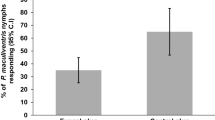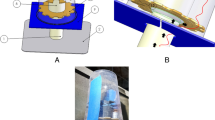Abstract
A choice test bioassay was devised to screen compounds as potential semiochemicals (e.g., kairomones or allomones that mediate aggregation, attraction or repellence) for the obligate parasitic mite, Psoroptes ovis. The choice test used filter paper discs in a 1:4 test:control ratio and was found to be a reliable, effective and efficient method. Four mammalian lipid components were assessed as potential attractants—linoleic acid, arachidonic acid, methyl myristate and squalene—, and the insect/tick repellent DEET for potential repellence. Linoleic acid was significantly attractive to P. ovis adult females and has the potential to act as an attractant. Identification of P. ovis semiochemicals, especially attractants, would be beneficial in the development of novel control methods and tools for this species. This is essential considering the increase in resistance to the limited prophylactic chemical treatments in the UK, and the high prevalence of scab infections.


Similar content being viewed by others
References
Anish RK, Latha BR, Ramanathan G, Sivagnanam UT, Sreekumar C, Leela V (2017) A novel assembly pheromone trap for tick control in dog kennels. Vet Parasitol 235:57–63
Arlian LG, Vyszenski-Moher DL (1995) Response of Sarcoptes scabiei var. canis (Acari: Sarcoptidae) to lipids of mammalian skin. J Med Entomol 32(1):34–41
Bates PG (1981) Recent advances in the biology and control of sheep scab. Proc Vet Soc 15: 23–27
Bates PG (2012) External parasites of small ruminants. A practical guide to their prevention and control. Cabi, Wallingford, p 224
Bissinger BW, Roe RM (2010) Tick repellents: past, present, and future. Pestic Biochem Physiol 96(2):63–79
Cadré RT, Millar JG (2004) Advances in insect chemical ecology. Cambridge University Press, Cambridge
Carr AL, Roe M (2016) Acarine attractants: chemoreception, bioassay, chemistry and control. Pestic Biochem Physiol 131:60–79
Chivers CA, Vineer HR, Wall R (2018) The prevalence and distribution of sheep scab in Wales: a farmer questionnaire survey. Med Vet Entomol 32:244–250
Clarke AM, Stephens FB, Cawley GD, Bellworthy SJ, Groves BA (1996) Resistance of the sheep scab mite (Psoroptes ovis) to propetamphos. Vet Rec 139:451
Coles G, Stafford K (1999) The in vitro response of sheep scab mites to pyrethroid insecticides. Vet Parasitol 83(3–4):327–330
Conte Y, Arnold G, Trouiller J, Masson C, Chappe B, Ourisson G (1989) Attraction of the parasitic mite Varroa to the drone larvae of honey bees by simple aliphatic esters. Science 245:638–639
Doherty E, Burgess S, Mitchell S, Wall R (2018) First evidence of resistance to macrocyclic lactones in Psoroptes ovis sheep scab mites in the UK. Vet Rec. https://doi.org/10.1136/vr.104657
Fang F, Bernigaud C, Candy K, Melloul E, Izri A, Durand R, Botterel F, Chosidow O, Huang W, Guillot J (2015) Efficacy assessment of biocides or repellents for the control of Sarcoptes scabiei in the environment. Parasites Vectors 8:416
Jamal GA, Hansen S, Apartopoulos F, Peden A, Abdul-Aziz M, Ballantyne JP (2001) Peripheral nerve dysfunction in farmers using organophosphate sheep dip. J Nutr Environ Med 11:9–22
Kirkwood AC (1980) Effect of Psoroptes ovis on the weight of sheep. Vet Rec 107(20):469–470
Lewis CJ (1997) Update on sheep scab. In Practice 19:558–564
Meintjes T, Fourie LJ, Horak IG (2002) On-host ecology and off-host survival of the sheep scab mite Psoroptes ovis. Onderstepoort J Vet Res 69:273–283
Meng H, Li AY, Costa Junior LM, Castro-Arellano I, Liu J (2016) Evaluation of DEET and eight essential oils for repellency against nymphs of the lone star tick, Amblyomma americanum (Acari: Ixodidae). Exp Appl Acarol 68(2): 241–249
Nieuwhof GJ, Bishop SC (2005) Cost of the major endemic diseases of sheep in Great Britain and the potential benefits of reduction in disease impact. Anim Sci 81:23–29
Ninomiya Y, Kawasaki T (1988) Acarid attractant. Japan Kokai Tokkyo Koho, Syo 63-230605
Norval RAI, Peter Y, Yunker CR, Soneshine DE, Burridge MJ (1992) Response of the ticks Amblyomma hebraeum and A. variegatum to known or potential components of the aggregation-attachment pheromones III. Aggregation Exp Appl Acarol 16:237–245
Norval RAI, Soneshine DE, Meltzer MI, Burridge MJ (1994) Attractant decoy for controlling bont ticks. United States Patent Office Patent No 5:296,277
O’Brien DJ, Gray JS, O’Reilly PF (1994) Survival and retention of infectivity of the mite Psoroptes ovis off the host. Vet Res Commun 18:27–36
Pilkington A, Buchanan C, Jamal GA, Gillham R, Hansen S, Kidd M, Hurley JF, Soutar CA (2001) An epidemiological study of the relations between exposure to organophosphate pesticides and indices of chronic peripheral neuropathy and neuropsychological abnormalities in sheep farmers and dippers. Occup Environ Med 58:702–710
Romero JR, Sanabria RE, Romero J, Sanchez RO, Lauriente P (2008) Resistance of Psoroptes ovis var, ovis to doramectin in sheep of Buenos Aires Province (Argentina). Veterinaria Argentina 25:662–666
Rose H, Wall R (2012) Endemic sheep scab: risk factors and the behaviour of upland sheep flocks. Prev Vet Med 104(1–2):101–106
Sanders A, Froggar P, Wall R, Smith KE (2000) Life-cycle stage morphology of Psoroptes mange mites. Med Vet Entomol 14:131–141
Sato M, Kuwahara Y, Matsuyama S, Suzuki T (1993) Chemical ecology of astigmatid mites XXXVII. Fatty acid as food attractant of astigmatid mites, its scope and limitation. Appl Entomol Zool 28:565–569
Smith KE, Wall R, French NP, Berriatua E (1999) Effects of temperature and humidity of the off-host survival of the mites Psoroptes ovis and Psoroptes cuniculi (Acari: Psoroptidae). Vet Parasitol 83:265–275
Sonenshine DE (2006) Tick pheromones and their use in tick control. Annu Rev Entomol 51:557–580
Skelton AC, Cameron MM, Pickett JA, Birkett MA (2010) Identification of neryl formate as the airborne aggregation pheromone for the American house dust mite and the European house dust mite. J Med Entomol 47(5):788–804
Stelinski L, Siddharth T (2013) Vertical T-maze choice assay for arthropod response to odorants. J Vis Exp 72:1–5
Synge BA, Bates PG, Clark AM, Stephens FB (1995) Apparent resistance of Psoroptes ovis to flumethrin. Vet Rec 137:51
Tarry DW (1974) Sheep scab: its diagnosis and biology. Vet Rec 95(23):530–532
Tuma D, Sinha RN, Muir WE, Abramson D (1990) Odour volatiles associated with mite infested bin-stored wheat. J Chem Ecol 16:713–724
Vet LEM, van Lenteren JC, Heymans M, Meelis E (1983) An airflow olfactometer for measuring olfactory responses of hymenopterous parasitoids and other small insects. Physical Entomology 8:97–106
Virtue WA, Clayton JW (1997) Sheep dip chemicals and water pollution. Sci Total Environ 194–195:207–217
Yee TW (2010) The VGAM package for categorical data analysis. J Stat Softw 32:1–34
Acknowledgements
The authors would like to thank the animal technicians for their assistance, and Mr. Bhushy Thind for useful discourse on sheep scab disease. All procedures within this study were carried out according to legislation required under the Animal (Scientific Procedures) Act 1986 (as amended).
Funding
This project was funded by the Veterinary Medicines Directorate of the UK Department for Environment, Food and Rural Affairs (Grant No. VM0514).
Author information
Authors and Affiliations
Corresponding author
Additional information
Publisher's Note
Springer Nature remains neutral with regard to jurisdictional claims in published maps and institutional affiliations.
Rights and permissions
About this article
Cite this article
Dunn, J.A., Prickett, J.C., Collins, D.A. et al. Choice test to determine potential attractants and repellents for the sheep scab mite, Psoroptes ovis (Acari: Psoroptidae). Exp Appl Acarol 79, 187–194 (2019). https://doi.org/10.1007/s10493-019-00416-x
Received:
Accepted:
Published:
Issue Date:
DOI: https://doi.org/10.1007/s10493-019-00416-x




